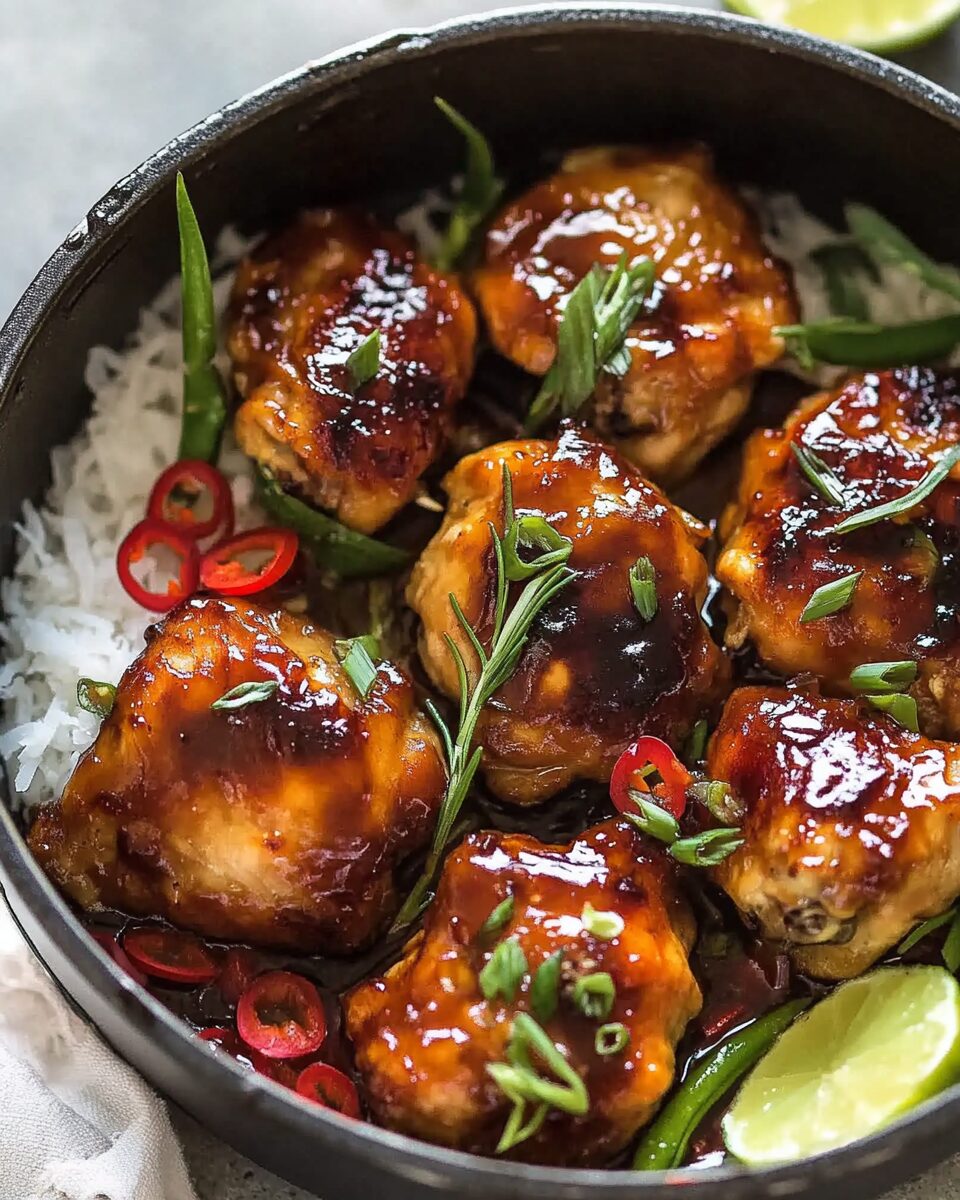Vietnamese Coconut Caramel Chicken is a delightful fusion of sweet and savory flavors, combining tender chicken thighs with a luscious sauce made from caramelized sugar, coconut milk, and fish sauce. The combination of garlic, ginger, and chili adds a fragrant depth, while the caramel gives the dish a unique richness that balances perfectly with the fresh coriander and lime juice garnish.
This recipe is perfect for when you’re craving something indulgent yet easy to make. With minimal prep time and a simple one-pan approach, it’s an ideal weeknight meal that feels exotic and comforting at the same time. Serve it over a bowl of steamed jasmine rice to soak up the flavorful sauce, and you’ve got a dish that’s bound to impress any dinner guest.
Full Recipe:
- 6 skinless, boneless chicken thighs
- 1 can (400ml) coconut milk
- 1/3 cup brown sugar
- 1 tablespoon fish sauce
- 2 tablespoons soy sauce
- 1 onion, finely sliced
- 4 garlic cloves, minced
- 1 tablespoon ginger, minced
- 1 red chili, sliced (optional)
- 1 tablespoon lime juice
- Fresh coriander and sliced green onions for garnish
- Steamed jasmine rice, for serving
Directions:
- Heat a large skillet over medium heat. Add the brown sugar and let it melt, stirring occasionally until it caramelizes to a golden brown color.
- Add the coconut milk, fish sauce, and soy sauce to the caramel. Stir to combine.
- Add the onion, garlic, ginger, and chili (if using). Cook for about 3 minutes until the onion starts to soften.
- Place the chicken thighs in the sauce, turning to coat them well. Cover and simmer on low heat for 25-30 minutes, turning occasionally.
- Remove the lid and let the sauce thicken slightly for another 5-10 minutes.
- Stir in lime juice and garnish with fresh coriander and sliced green onions.
- Serve the chicken with the coconut caramel sauce over steamed jasmine rice.
Prep Time: 10 minutes | Cooking Time: 40 minutes | Total Time: 50 minutes
Kcal: 450 kcal | Servings: 4 servings
Vietnamese Coconut Caramel Chicken: A Culinary Journey
Vietnamese Coconut Caramel Chicken, or Gà Kho Nước Dừa, is a beloved dish that beautifully embodies the harmony of sweet and savory flavors characteristic of Vietnamese cuisine. This dish is not only a staple in Vietnamese households but also a favorite among those who enjoy Asian flavors. The combination of caramelized sugar and rich coconut milk creates a sauce that clings to the tender chicken thighs, resulting in a meal that is both comforting and indulgent.
Origins and Cultural Significance
- Culinary Heritage: This dish originates from the southern regions of Vietnam, where coconut trees flourish, making coconut milk a common ingredient in local cuisine. The use of coconut milk is prevalent in many dishes from this region, contributing to a unique flavor profile that is rich and creamy.
- Family Recipes: Traditionally, Vietnamese Coconut Caramel Chicken is often made using family recipes passed down through generations. Each family may have its variations, incorporating different spices or levels of sweetness based on personal preferences.
- Festive Occasions: This dish is often served during special occasions and family gatherings, highlighting its importance in Vietnamese culture. It symbolizes the comfort of home and the joy of sharing meals with loved ones.
Flavor Profile
- Sweetness: The caramelized sugar is the star of this dish, giving it a sweet yet complex flavor. This sweetness is balanced by the saltiness of the fish sauce, creating a nuanced taste that is both sweet and savory.
- Umami: Fish sauce is an essential ingredient in Vietnamese cooking, adding a depth of umami flavor. This savory note enhances the overall taste, making it a well-rounded dish.
- Creaminess: The coconut milk contributes a luscious creaminess, making the sauce velvety and rich. This creaminess also helps to mellow out the flavors, creating a harmonious balance.
- Aromatic Herbs: Fresh coriander and lime juice add brightness and freshness to the dish, cutting through the richness and enhancing the overall flavor profile.
Nutritional Benefits
- Protein: Chicken thighs provide a good source of protein, which is essential for muscle repair and growth.
- Healthy Fats: Coconut milk contains medium-chain triglycerides (MCTs), which are considered healthy fats. These fats can provide quick energy and may have various health benefits.
- Vitamins and Minerals: Fresh herbs, such as coriander, add vitamins and antioxidants, contributing to overall health.
- Low Carb: This dish can be low in carbohydrates, especially when served with steamed vegetables instead of rice, making it suitable for those following a low-carb diet.
Cooking Techniques
- Caramelization: The process of melting sugar until it turns golden brown is known as caramelization. This technique is crucial in this recipe as it creates the base for the sauce. Caramelization brings out the sugars’ natural flavors, giving the dish its signature taste.
- Simmering: Cooking the chicken in the sauce allows the flavors to meld together. This slow cooking method ensures the chicken is tender and infused with the sauce’s flavors.
- One-Pan Cooking: This dish is typically made in one pan, simplifying the cooking process and reducing cleanup. The use of a skillet or wok makes it easy to manage the cooking process and allows for even heat distribution.
Variations
- Protein Alternatives: While chicken is the traditional choice, you can substitute it with pork, tofu, or shrimp for a different take on the dish. Each protein will absorb the flavors of the sauce differently, providing a unique culinary experience.
- Spice Level: For those who enjoy a kick, consider adding more chili peppers or incorporating spicy elements like Sriracha or chili flakes. This can elevate the dish and appeal to spice lovers.
- Vegetable Additions: You can incorporate vegetables like bell peppers, carrots, or green beans into the dish for added nutrition and texture. These vegetables can absorb the sauce, enhancing their flavor.
- Herb Choices: Fresh basil or mint can be used in place of coriander for a different aromatic profile. Experimenting with herbs can provide unique twists on the dish.
Serving Suggestions
- Steamed Rice: The most common accompaniment is steamed jasmine rice, which perfectly soaks up the rich sauce, making every bite a delight.
- Salads: Pair with a light Vietnamese salad, such as Gỏi Đu Đủ (Papaya Salad) or a fresh herb salad, to balance the richness of the chicken.
- Spring Rolls: Serve with fresh spring rolls for a complete Vietnamese dining experience, allowing guests to enjoy a variety of flavors and textures.
Storing and Reheating
- Storage: Leftovers can be stored in an airtight container in the refrigerator for up to 3 days. The flavors often intensify as the dish sits, making the leftovers even more enjoyable.
- Freezing: While it’s best enjoyed fresh, you can freeze the chicken in its sauce for up to a month. Thaw in the refrigerator overnight before reheating.
- Reheating: To reheat, gently warm on the stovetop over low heat to prevent the sauce from separating. Adding a splash of water or coconut milk can help restore the sauce’s creamy consistency.
Conclusion
Vietnamese Coconut Caramel Chicken is a delightful dish that encapsulates the essence of Vietnamese cooking through its harmonious blend of flavors and textures. Its rich history and cultural significance make it more than just a meal; it’s a celebration of family and tradition. Whether you’re looking for a comforting dinner option or an impressive dish to share with friends, this recipe is sure to satisfy and impress. Its versatility allows for endless variations, making it a staple recipe that can be enjoyed time and time again.
Incorporating this dish into your culinary repertoire not only expands your cooking skills but also connects you with the rich heritage of Vietnamese cuisine. So gather your ingredients, and enjoy the process of creating this flavorful dish that brings a taste of Vietnam to your table!





